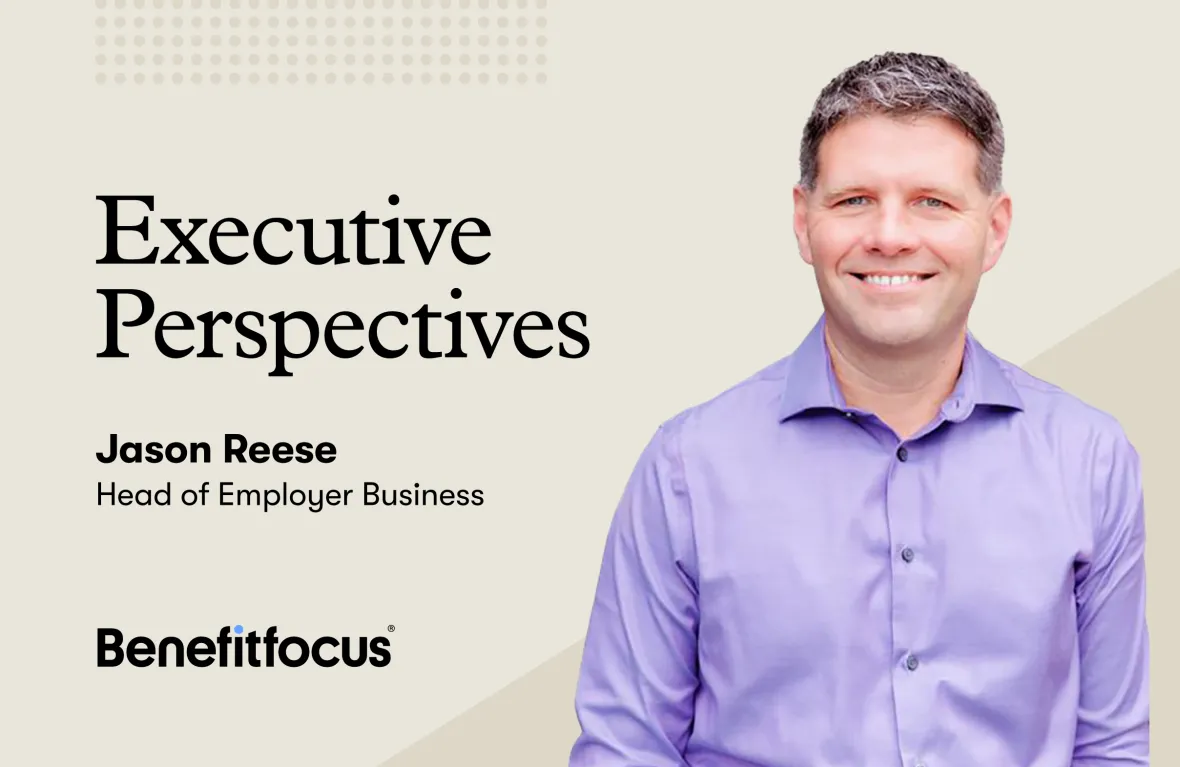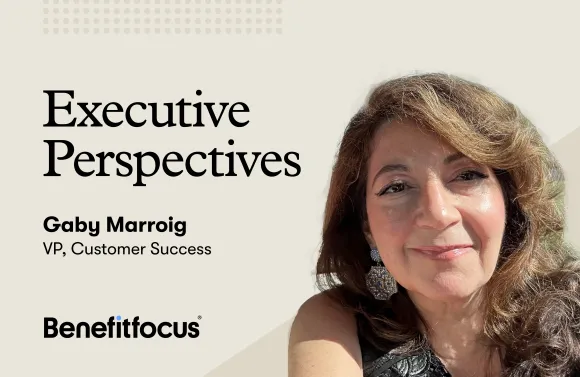
Our latest edition of Executive Perspectives brings insight from Jason Reese, Head of Employer Business at Benefitfocus. In this Q&A, Jason discusses some of the interesting opportunities that artificial intelligence (AI) can bring to the benefits industry.
Q: What are some of the ways that AI is currently shaping the benefits industry?
Jason: AI is creating significant efficiencies for the benefits industry, which is often overwhelmed with back-office processing. These high-volume administrative tasks like claims processing, call routing and call/data summarization have historically created a burden for under-resourced HR teams. AI technology is increasingly making it possible for HR teams to offload these tasks and focus on more strategic projects. It will be interesting to see how we take advantage of AI to go beyond just back-office processes to support things like employee engagement and communications.
Q: Are there any areas within the benefits industry that continue to struggle with effective AI implementation?
Jason: The benefits industry shares many of the same challenges that other industries have when implementing AI, such as privacy and security concerns. There is certainly a heightened sensitivity within the benefits industry, given the types of data we manage.
A 2025 report from McKinsey & Company noted that some of the biggest challenges for any organization adopting AI are aligning leadership, cost uncertainty and workforce planning. The report also mentions the importance of adaptability, considering the rapid rate at which AI is advancing. Trying to fit AI into your current processes has the potential to limit the use case, unless you’re willing to adapt.
I expect we’ll see the market for AI consulting grow at an accelerated pace as companies realize they have to leverage AI or get left behind, but don’t know where to begin or have the time, or expertise, to integrate into their organization.
Q: AI capabilities are continuously evolving to support many different business functions beyond human resources. In what ways have you seen organizations encouraging AI adoption within their workforce?
Jason: Business leaders are taking advantage of the buzz around AI to support a variety of goals. While still early in the full roll-out, I’ve seen organizations challenging their employees to use AI tools like Open AI’s ChatGPT or Microsoft Copilot to increase efficiency and then share what they learn with others. This is an easy way to both learn AI's functionality but also highlight use cases that may help others. And it is fairly easy to get started and doesn’t take a lot of time, so everyone is likely able to participate.
Q: You mentioned earlier your interest in seeing how AI could support employee-centric activities like employee engagement and communications. Can you share an example of how benefits leaders might use AI to address a common issue like low employee engagement during open enrollment?
Jason: Simplification of benefits and making the experience personal to me is a focus. What does that mean? I think that is the point – it means something different to each of us. And trying to solve for that at scale has always been a problem.
With AI, you have flexibility in communications, which could be used in combination with tools like Decision Support that begin to allow us to do things at scale that are more personalized. For example, I see the same medical plans as everyone else in my company. But rather than picking the same plan as the person next to me, how do I enter some information, or ask a few questions, to find out which plan is best for me? Even better, AI could potentially provide the reason why a certain plan is optimal for my situation.
As an employee, I would be more willing to spend time in process if I felt like the tools set me up for success and I learned a bit more about the best way to use my benefits along the way.
Q: What should be the first step in finding an AI solution for employee engagement?
Jason: It’s important to have an overall AI strategy as a company before looking into specific tools for a business function. An AI strategy will be different for every organization, but the foundational elements should include details such as the purpose of using AI, the risks and how to mitigate them, timelines for implementation and performance metrics. Once your AI strategy is defined and documented, you’ll be able to narrow your search in finding the right solution for your business goals. It seems that AI can do anything, but what we have already learned is that it is only as good as the inputs you provide and the questions you ask or tasks you assign. Having a strategy before jumping in can help you get organized before you start.
Q: What are some of the features that should be assessed in an AI solution for employee engagement?
Jason: Security and privacy are paramount for any AI solution. In addition, HR leaders may want to consider solutions that can function with less context and prior knowledge.
For example, employees may not engage during open enrollment because they don’t know how to solve a particular problem. These employees may have access to benefits data, documents and educational materials, but they don’t have the context of how to use them to solve their problems. Enabling AI to answer more generic questions regarding benefits, using AI to do the research across all the various inputs, can give these employees a simpler entry point into building their understanding of what benefits are available and how best to select and then use them to provide the best outcomes.
In this case, an HR leader might prioritize built-in guardrails that prevent false or misleading results, sometimes referred to as “hallucinations”, or inappropriate answers when replying to a user’s questions.
Beyond these features, it’s important to perform overall due diligence on the AI solution. Consider whether the solution is overseen by an AI Governance Board or a similar committee that will manage important functions such as risk management and policy development.
Q: Can you share some examples of how AI can help HR teams manage benefits more efficiently?
Jason: Any repetitive tasks or those that require analysis of large amounts of data would be prime candidates for AI usage. Think about a use case where a tool can recommend a better mix of benefits for your employees based on claims or other variable factors. While we see a lot happening for the employee to pick the right benefits, making sure you are offering the right selection for them to choose from is critical.
As I mentioned earlier, there is an opportunity for more personalization, at scale. Providing tools that allow interaction with an employee about their unique needs not only helps with their engagement but could take a huge burden off the HR teams’ shoulders.
An example of this personalization would be an intelligent chatbot that leverages a closed architecture knowledgebase to provide an employee with personalized guidance. This capability enables employees to self-serve their benefits needs and helps lessen the burden on benefits administrators.
Q: Employee benefits cost containment can be challenging due to factors like rising health care costs, poor employee decisions and administrative inefficiencies. How can AI be used to address some of these issues?
Jason: Traditionally, we have only been able to communicate generic messages about benefits broadly. But as an employee, I need to know how those benefits work for me in my specific situation. And what else I should be thinking about that I might not know.
An employee that’s expecting their first baby might be thinking about immediate healthcare needs, but personalized messaging created by AI might prompt them to think of other issues like finding a pediatrician and a financial advisor.
Getting an employee into the optimal benefits programs both now and in the future can play a meaningful role in cost containment. Where AI will help is in the utilization of those benefits. Having somewhere to go to get answers about ‘what next’ when I have a benefit related matter to address has the potential to help to contain cost in the moment.
Q: How is Benefitfocus currently using AI to improve the benefits experience?
Jason: Our AI strategy centers around the goal of radically simplifying the benefits experience. To achieve this, we’re taking a phased approach and organizing our data to be leveraged effectively by AI. Our current AI use cases generally support personalization and efficiency across the employee and administrator experiences, as well as operational support.
On the employee side, AI is used in our chatbot assistant. On the administrator side, AI is used in tasks such as assisted document review and dependent verification. AI is also used in operational support to assess calls, automate renewal processes and identify data impacts.


